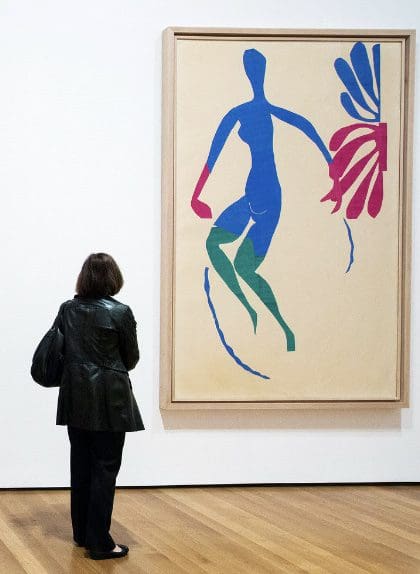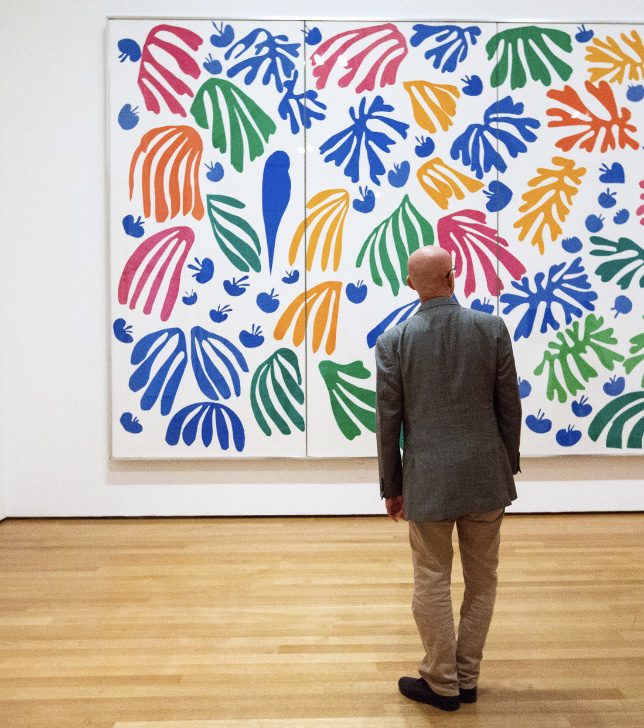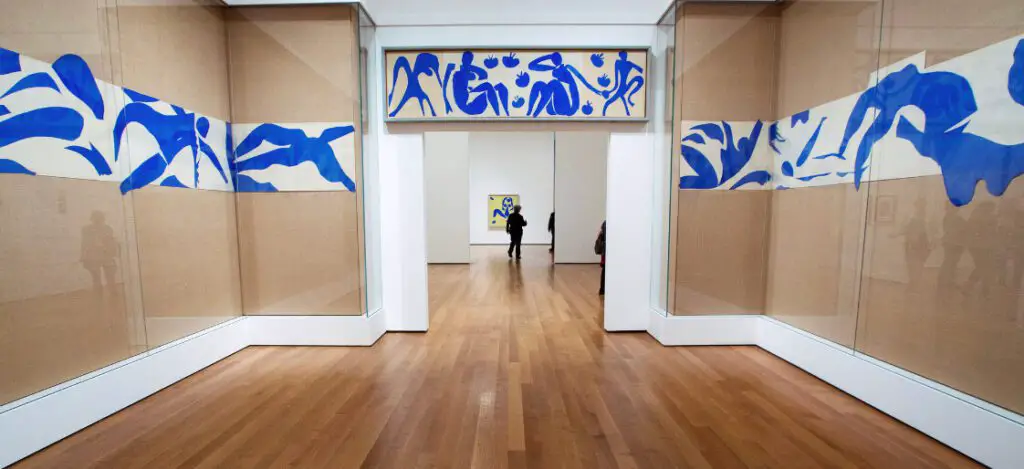In the artistic world, the concluding years of an artist’s life are frequently seen as their pinnacle, encapsulating a life’s journey of trial, learning, and eventual mastery. This perception holds unquestionably true for Henri Matisse, the renowned French artist. In his final ten years, Matisse delved into an artistic exploration of materials that led to his most groundbreaking and celebrated works: the cut-outs.
Utilizing the minimalism of white paper and gouache, Matisse wielded a non-traditional tool—scissors—to create a universe teeming with life, expressed through plants, animals, figures, and shapes. This innovative endeavor, ‘The Cut-Outs,’ symbolized a transformative shift in Matisse’s artistic journey, underscoring his talent to distill the crux of form through an ingenious process of painting and cutting.
Table of Contents
- Unfolding Creativity: The Cut-Outs Of Henri Matisse
- Shaping An Artistic Legacy
- Frequently Asked Questions
- Related Questions
Unfolding Creativity: The Cut-Outs Of Henri Matisse
Henri Matisse’s adoption of cut-outs and use of gouache paint during the later stages of his life marked a radical departure from traditional artistic mediums and practices, paving the way for a unique and innovative artistic language.

Suffering from cancer and using a wheelchair, Matisse found physical painting increasingly challenging. However, he turned these limitations into a creative opportunity. Instead of using a paintbrush, Matisse began using scissors to cut into painted paper, thus “carving into color,” as he described. This technique allowed him to continue creating physically less demanding art but no less complex or profound. It was a testament to his unyielding passion for art and his ability to adapt and innovate despite adversity.
Henri Matisse And The Use Of Gouache Paint
Moreover, gouache paint was a critical component in Matisse’s cut-outs. Unlike oil or acrylic paint, gouache is water-based, dries quickly, and is easily manipulated. Matisse and his studio assistants would paint sheets of paper with this paint, creating a palette of vibrant colors. These were then cut into shapes and forms, producing a hybrid work that blurred the lines between painting and sculpture.
Matisse’s gouache gave him a broader spectrum of colors, allowing for a bolder, more vivid expression in his cut-outs. The opacity and matte finish of gouache enabled the cut-outs to retain their color saturation and intensity, creating a dynamic interplay of color and form.
The combination of cut-outs and gouache paint resulted in works that were at once simple yet complex, reflecting the dual nature of Matisse’s artistic approach in his later years. The cut-outs showcased Matisse’s ability to distill his decades-long exploration of color and form into its purest essence. It was a bold and novel way of expressing his artistic vision, confirming his status as one of the leading figures of 20th-century art.
Unraveling The Cut-Outs
The Cut-Outs were a multi-phase creative endeavor. The process began with Matisse procuring the primary materials: white paper and gouache, a type of water-based paint known for its opacity and quick-drying quality. Matisse’s studio assistants would then paint the sheets of paper with gouache, creating a palette of vividly colored papers.
Matisse would next select sheets and cut out shapes, allowing the remaining paper to fall to the studio floor. This action was not random but a carefully thought-out process, demonstrating his masterful command of form and shape. Larger compositions necessitated the help of his assistants, who would guide the paper to ensure smooth and continuous cuts.

Different-sized scissors were used, and while Matisse was famously filmed using large ones, close examination of the cut-outs suggests various sizes were employed. Despite the seemingly chaotic process, Matisse’s cut-outs were not accidental but deliberate, reflecting his acute sensitivity to form and color.
Painting With Paper
The color in Matisse’s cut-outs came from the gouache. Unlike oil or acrylic paint, gouache is opaque and matte, dries quickly, and can be diluted with water. Matisse procured a range of colors from supply houses in Paris and Nice, basing his choices on color quality and freshness.

The paint was thinned with water and applied to the sheets of paper, which were then left to dry. The brushstrokes were often visible, hinting at the underlying painting process. The result was a dense, vibrant palette of colors, ready to be transformed into cut-outs.
Shaping An Artistic Legacy
When working on a specific project, Matisse would request an assortment of painted sheets to be spread out on the studio floor. He then selects sheets and starts cutting, creating various shapes and forms.
Some cut-outs were created from a single sheet of paper, while others, like the recurring motif of stars, were assembled from multiple smaller shapes. In some instances, the multiple pieces overlapped; in others, large cut-outs were overlaid with yet another cut-out. What mattered was not the layered structure but the final outline of the form, which was the artist’s ultimate goal.

The Cut-Outs marked a significant departure from Matisse’s previous work. Matisse found freedom in this innovative art form despite physical constraints in his later years. It redefined his artistic language, simplifying his earlier explorations of color and form into a more abstract, yet no less complex, medium.
The Cut-Outs embodied a sense of energy, movement, and life, transforming ordinary paper and paint into a complex world of color and form. Despite the simplicity of the materials and the unorthodox method of creation, Matisse’s cut-outs exhibit a depth of thought, a sensitivity to form, and an unabashed celebration of color.
Matisse once said,
“I don’t paint things. I only paint the difference between things.”
Henri Matisse
He magnified this idea in the Cut-Outs, using simple materials to bridge the gap between painting and sculpture. Matisse’s inventive spirit thrived until the very end of his life, and his Cut-Outs stand as a testament to the artist’s ability to reinvent himself and his art, even in the face of physical adversity.
The Cut-Outs of Henri Matisse is a testament to the endless possibilities of creativity. They serve as a reminder that conventional materials or techniques do not bind artistic expression but thrive in innovation and experimentation.
Through his Cut-Outs, Matisse transformed the simple act of cutting paper into a revolutionary art form that continues to inspire and influence artists today.
The Swimming Pool (1952) – Memorizing Cut-Out

In the summer of 1952, Henri Matisse, the renowned artist, expressed his desire to witness divers in action. Accompanied by his studio assistant and secretary, Lydia Delectorskaya, they embarked on a trip to a beloved pool in Cannes.
However, the scorching sun proved too much, compelling them to return home. Undeterred, Matisse resolved to create his pool in his dining room’s confines at the Hôtel Régina in Nice.
Envisioning his masterpiece, he instructed Delectorskaya to encircle the dining room walls with a strip of white paper strategically positioned just above his eye level, broken only by the windows and door at opposite ends. The room’s interior was adorned with tan burlap, a fashionable wall covering that era.

Matisse then skillfully crafted his divers, swimmers, and sea creatures by cutting paper painted in a striking ultramarine blue. These blue forms were meticulously pinned onto the white paper, giving life to an aquatic ballet of bodies, splashing water and light.
The outcome was an extraordinary piece of art known as “The Swimming Pool,” which stood as Matisse’s sole self-contained, site-specific cut-out. Demonstrating his mastery, this artwork showcased a reduction of forms, a dynamic interplay between positives and negatives, and a lateral expansion across the walls.
Matisse perceived the flexibility of paper as the ideal representation of the fluidity of water, resulting in a seamless fusion of subject and artistic medium, making “The Swimming Pool” a truly remarkable and captivating masterpiece.
Anita Louise Art is dedicated to art education, great artists, and inspiring others to find and create their art. We love art that uplifts and inspires. #ArtToMakeYouSmile! #ArtToMakeYouHappy!
If you want to see any of my art, you can find out more by clicking here. If you are interested in what inspires me and my paintings, you can discover more by clicking here.
We have a free newsletter and would love you to be part of our community; you can subscribe to the newsletter by clicking here. If you have any questions, I would be happy to talk to you. You can reach me, Anita, by clicking here.
Subscribe to our Anita Louise Art YouTube Channel with great videos and information by clicking here.
Join us for our podcast “5 Minutes With Art.” Spend 5 minutes a week with us to discover and learn about great art and artists. You can find out more about our podcast by clicking here.
Frequently Asked Questions
What inspired Henri Matisse to venture into the realm of cut-outs and explore new materials in his final years?
Henri Matisse’s shift to cut-outs was inspired by a desire for artistic exploration. The constraints of his physical health led him to adapt his creative process, ultimately leading to the innovative use of scissors and unconventional materials.
How did Henri Matisse utilize white paper and gouache in his cut-out works, and what significance did these materials hold for him?
Matisse employed the simplicity of white paper as his canvas and gouache as a medium to add color and depth to his cut-outs. The deliberate use of these minimalistic materials played a crucial role in defining the visual language of his later works.
Can you elaborate on the role of scissors as a tool in Matisse’s creative process, and how did it contribute to the uniqueness of ‘The Cut-Outs’?
Matisse’s use of scissors was a departure from traditional painting techniques. He utilized scissors to meticulously cut out shapes, allowing him to explore a new dimension in his artistic expression. This unconventional approach added a dynamic and tactile quality to his creations.
What subjects did Matisse explore through ‘The Cut-Outs,’ and how did this technique allow him to convey a vibrant and lively universe?
Matisse’s cut-outs featured a diverse array of subjects, including plants, animals, figures, and abstract shapes. The combination of these elements, crafted through the cut-out technique, contributed to the creation of a vibrant and lively artistic universe.
How did the use of cut-outs symbolize a transformative shift in Henri Matisse’s artistic journey?
Matisse’s adoption of cut-outs marked a significant transformation in his artistic style. Moving away from traditional painting, he embraced a more intuitive and direct approach, allowing him to distill the essence of form through the act of cutting and arranging shapes.
What challenges did Henri Matisse face while working on ‘The Cut-Outs,’ particularly in terms of physical limitations and health constraints?
Matisse’s physical health, especially in his later years, presented challenges to his artistic process. Limited mobility compelled him to adapt, leading to the unconventional use of scissors and cut-outs as a means of artistic expression.
How did ‘The Cut-Outs’ showcase Matisse’s ability to distill the essence of form through the intricate process of painting and cutting?
Matisse’s cut-outs demonstrated his mastery in distilling the essence of form. Through the meticulous process of painting and cutting, he achieved a harmonious balance between simplicity and complexity, capturing the core of each subject.
Were there specific themes or motifs that recurred in Matisse’s cut-out works, and what significance did they hold for the artist?
Certain themes, such as nature, dance, and the human figure, recurred in Matisse’s cut-out works. These motifs held personal and symbolic significance for the artist, representing themes that resonated deeply with his life and experiences.
How did critics and the art community initially respond to Henri Matisse’s cut-out works, considering the departure from his earlier artistic styles?
The introduction of ‘The Cut-Outs’ represented a departure from Matisse’s earlier styles, and initial reactions from critics and the art community varied. Understanding how the art world responded to this innovative approach provides insight into the broader reception of Matisse’s late-career works.
What lasting impact have Henri Matisse’s cut-out works left on the art world, and how have they influenced subsequent generations of artists?
Examining the legacy of Matisse’s cut-outs allows us to understand their lasting impact on the art world. Exploring how these works have influenced and inspired later generations sheds light on their significance in the context of art history.
Related Questions
What Was The Focus Of Renaissance Art?
Renaissance art focused on the classics of Greek and Rome, humanist philosophy, and the study of the human figure. Realism was also an essential part of renaissance art. The great artists of the Renaissance also became great anatomists and studied human beings.
By clicking here, you can learn more by reading What Was The Focus Of Renaissance Art?.
What Is The Importance Of Art From The Renaissance Period?
Renaissance art is essential as it was a time of rebirth and discovery. Artists like Leonardo da Vinci, Michelangelo, and Raphael were at the forefront of that change, creation, and discovery. Renaissance art has influenced art and artists for many centuries and continues to influence artists today.
By clicking here, you can learn more by reading What Is The Importance Of Art From The Renaissance Period?.
21 Top Renaissance Artists And Their Works Of Art
When we speak of top Renaissance artists, we think of the trinity of artists like Leonardo da Vinci, Michelangelo, and Raphael. But besides these three artists, many other influential Renaissance artists remain essential.
By clicking here, you can learn more by reading 21 Top Renaissance Artists And Their Works of Art.

